Home >> Diversity and classification >> True fungi >> Dikarya >> Ascomycota >> Plectomycetes >> Plectomycetes with discomycetous origins
PLECTOMYCETES WITH DISCOMYCETOUS ORIGINS
Members of both the Leotiomycetes and Pezizomycetes have given rise to cleistothecial forms. The origins of these plectomycetes are not necessarily obvious; most have only been resolved using genetic tools. Three orders can be recognized: the Erysiphales, the Myxotrichales and the Pezizales.
The Erysiphales or powdery mildews
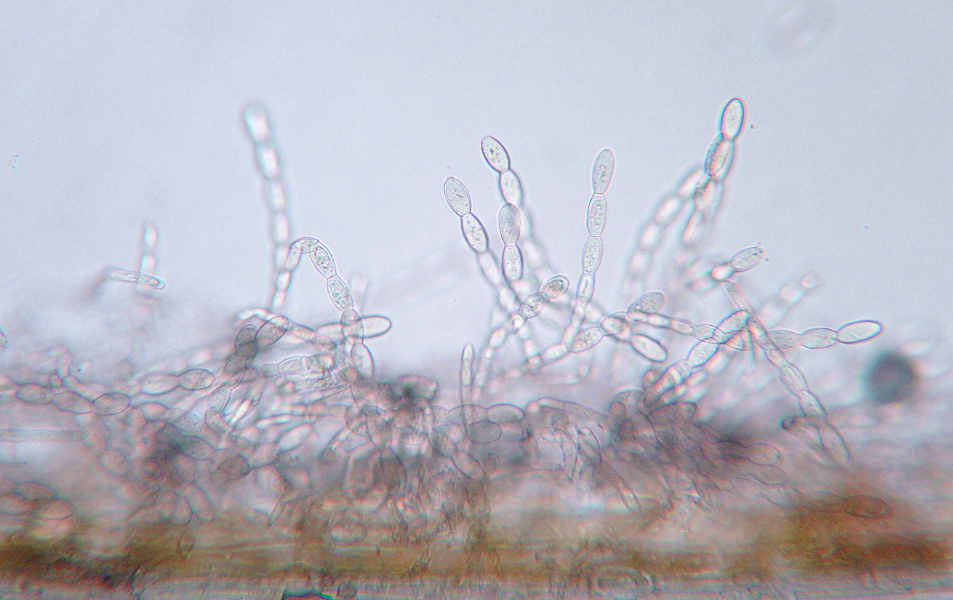

The Erysiphales form a large group of plectomycetes causing a disease in plants called powdery mildew. As the picture of a powdery mildew on willow at right shows, the name is quite appropriate. These are obligate parasites, meaning that they cannot grow in the absence of the plant. They occur on the leaves of a great variety of plants and may become abundant enough to damage them. In a typical powdery mildew life cycle the plant becomes infected early in the growing season. As the fungus becomes established it begins to produce chains of white conidia (asexual spores) on the surface of the leaves, illustrated at far right by Blumeria graminis on the surface of a blade of grass. These can become abundant, as in the picture, giving the leaf a white powdery appearance. Later in the season the cleistothecia begin to form, often on the underside of the leaf. The cleistothecia spend the dormant season attached to the dead leaf or they may become detached and cling to nearby vegetation. At the beginning of the new growing season the cleistothecia break open and release their ascospores.
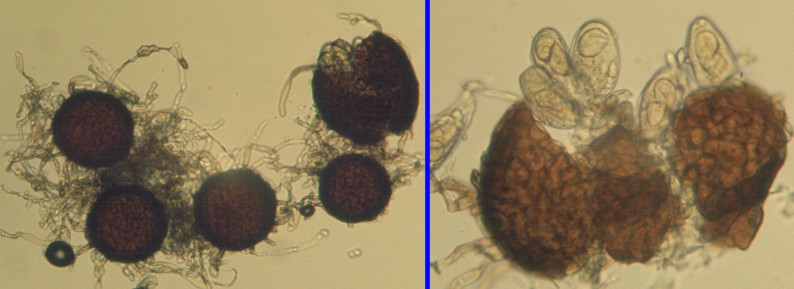
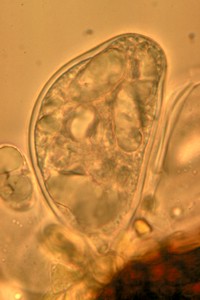
The cleistothecia of Erysiphe cichoracearum, a common parasite of members of the sunflower family, seen in the two pictures above left, are reddish brown and lack an ostiole. They are covered with prominant hyphae that can become highly distinctive in some genera. When the cleistothecia open, as in the middle panel, the asci are able to emerge. These are usually club-shaped and contain one to eight colourless single-celled ascospores. The Erysiphales are not typical plectomycetes because their asci have the ability to burst and disperse their ascospores forcibly into the air.
The picture in the right panel offers a close-up view of of an ascus of Uncinula flexuosa. The wall is relatively thick, unlike that of most plectomycetes. It is less thick at the top of the ascus where it bursts open to release the ascospores. The ascospores cannot be seen very clearly in the ascus because they are still rather immature and unformed. This collection was made in the autumn when the asci were not ready to release their ascospores. A return visit to the same site in the spring yielded mature asci and ascospores. The host plant for Uncinula flexuosa is the horse chestnut. In the spring its leaves litter the ground and are covered with cleistothecia of the mildew.
The cleistothecia of Uncinula flexuosa, below left, are covered with elegant appendages, each with a terminal hook. This is a characteristic of all species of Uncinula, including Uncinula salicis, the fungus causing the powdery mildew of willow in the picture at the top of this page. The function of these hairs is unknown; they are similar to the cleistothecial appendages of plectomycetes living in animal-associated habitats, which are thought to catch in the fur or feathers of animals. However, it is difficult to imagine such a role for the appendages of Uncinula species. The other three pictures below illustrate some other species of powdery mildews. The one in the panel second to left is Microsphaera diffusa, collected on tick-trefoil (Desmodium canadense). Species of Microsphaera have cleistothecial appendages that are branched at the tip. The panel second to right shows a cleistothecium of Podosphaera clandestina, a common parasite of cherries. Species of Podosphaera resemble those of Microsphaera but differ in having only one ascus in each cleistothecium. The right panel presents cleistothecia of Phyllactinia guttata. This common mildew of alder and birch has cleistothecial appendages that are strongly bulbous at their base and taper out to a point. The cleistothecia also have unusual "brush cells" on their tops. At the end of the growing season, or at the beginning of the next, the cleistothecia are raised up on their appendages by the unequal growth or contraction of the bulb and they thus appear to be standing on little legs. They become detached from the leaf and stick to surrounding vegetation by the brush cells. Winter collections of dried twigs often reveal these little fungi, much to the surprise of students when they first encounter them.
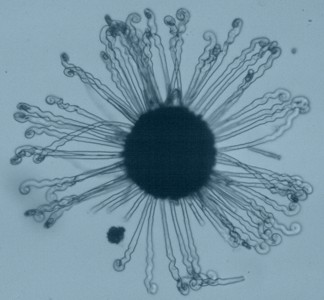

The Myxotrichales
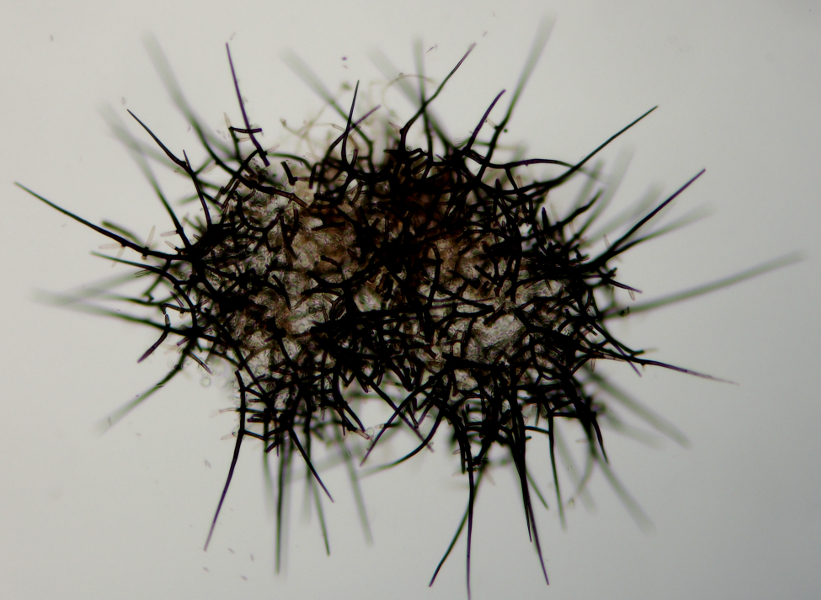
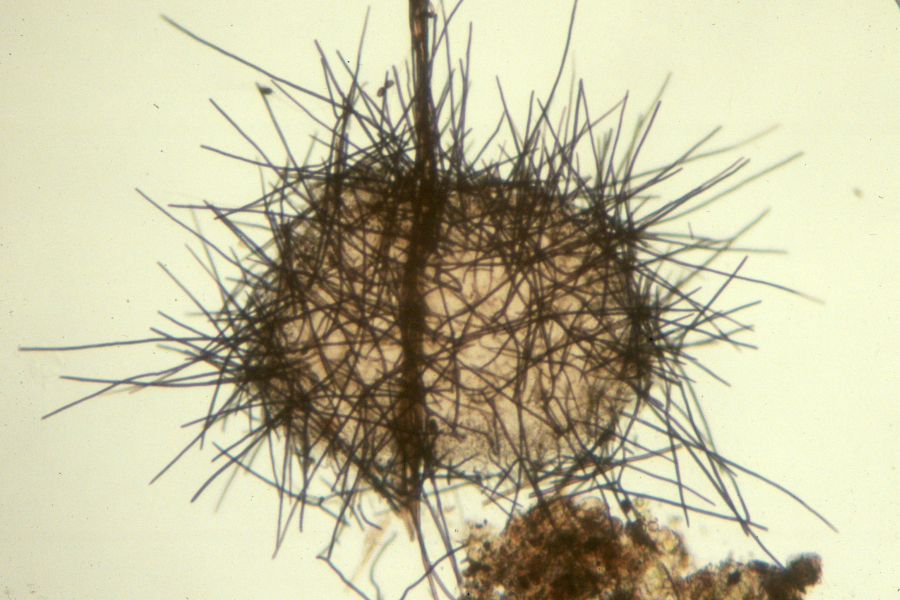
These unusual fungi appear to belong to the Onygenales because of their production of gymnothecia. Two species of Myxotrichum, M. ochraceum and M. deflexum are shown in the prictures at right. The dark coloured elements of the gymnothecia contrast strongly with the mass of colourless ascospores. These species differ from those of the Onygenales in their ability to digest cellulose and in their occurrence in habitats not associated with vertebrate animals. They often turn up in studies of indoor moulds where they are found on old cardboard and other cellulosic materials. Some species of Myxotrichum produce asexual stages belonging in the genus Oidiodendron.

Pseudogymnoascus roseus, another member of the Myxotrichales, is even more similar to the Onygenales. The gymnothecial elements here are pinkish to orange in colour, just as they are in the Onygenales. It is most commonly isolated from forest soils where it is capable of decomposing wood and other plant materials at low temperatures. It may also be able to enter into mycorrhizal relationships with members of the blueberry family. Species of Pseudogymnoascus produce asexual stages in the genus Geomyces.
The Pezizales
Several groups of operculate discomycetes have given rise to cleistothecial species. Many of these, such as Orbicula and Lasiobolidium are very similar to ordinary Pezizales and are immediately recognized as such. Others, such as Coprotiella and Cleistothelebolus are much more reduced in structure. Most members of this group occur on dung and are most closely related to dung-inhabiting discomycetes. The most notable exception to this is Orbicula parietina which grows on composting plant materials at low temperatures.